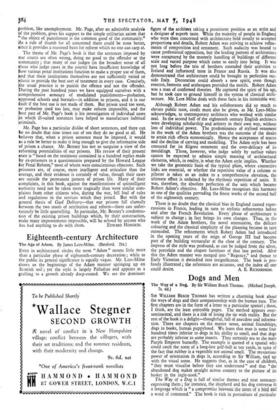Eighteenth-century Architecture
The Age of Adam. By James Lees-Milne. (Batsford. 21s.)
EVEN in architectural circles the term " Adam " means little more than a particular phase of eighteenth-century decoration ; while to the public its general significance is equally vague. Mr. Lees-Milne shows us the beginnings of the Adam manner springing up on Scottish soil ; yet the style is largely Palladian and appears as a grafting to a growth already deep-rooted. We see the dominant
figure of the architect taking a prominent position as an artist and i a designer of superb taste. While the majority of people in England who were then concerned with architecture held stoutly to accepted proportions and details, Robert Adam was striving to achieve refine- ments of composition and ornament. Such audacity was bound to cause professional opposition, but the leading patrons of architecture were enraptured by the masterly handling of buildings of different scale and varied purpose which came so easily into being. It was not long before the trio of brothers extended their activities to Ireland and influenced taste in France and Russia. It was also demonstrated that architecture could be brought to perfection out- side Italy. Decoration could absorb a new spirit, even though rosettes, festoons and arabesques provided the motifs. Robert Adam was a man of confirmed theories. He captured the spirit of his age, but he took care to ground himself in the syntax of classical archi- tecture. Mr. Lees Milne deals with these facts in his inimitable way.
Although Robert Adam and his collaborators did so much to elevate public taste, credit must also be given, as Mr. Lees-Milne acknowledges, to contemporary architects who worked with similar zeal. In the second half of the eighteenth century English architects were developing scholarship and artistry in their own way, without loss of individual power. The predominance of stylised ornament in the work of the Adam brothers was the outcome of the desire to attain rich effects economically. Hence the acceptance of stucco and the decline of carving and modelling. The Adam style has been censured for its filigree ornament and the over-delicacy of its mouldings. Those, however, who judge solely by surface values cannot be expected to admire simple massing of architectural elements, which, in reality, is what the Adam style implies. Whether we take the geometric basis of the typical plans, where connective links are essential, or whether the repetitive value of a column or pilaster is taken as an index to a comprehensive elevation, the ultimate effect is ordained by the rhythmic repetition of units. It was, therefore, the absolute perfection of the unit which became Robert Adam's objective. Mr. Lees-Milne recognises this harmony as one of the qualities pervading the finest works of the second half of the eighteenth century.
There is no doubt that the classical bias in England caused reper- cussions in France, leading in turn to stylistic refinements before and after the French Revolution. Every phase of architecture is subject to change ; in fact brings its own changes. Thus, in the work of the Adam brothers, the novel attenuation, the delicate colouring and the classical simplicity of the planning became in turn outmoded. The refinements which Robert Adam had introduced in the opening years of the reign of George III had become part of the building vernacular at the close of the century. The impress of the style was profound, as can be judged from the silver, the porcelain and the elegant furniture of that late period. After this the Adam manner was merged into " Regency," and thence to Early Victorian it dwindled into insignificance. The book is pro- fusely illustrated ; the references are accurate, and the index all one


































 Previous page
Previous page